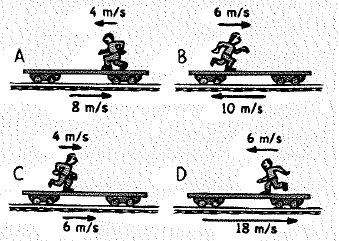
Concept explainers
Jogging Jake runs along a train flatcar that moves at the velocities shown. In each case, Jake’s velocity is given relative to the car.

Rank the following from greatest to least.
a. the magnitude of Jake’s momentum relative to the car
b. Jake’s momentum to the right relative to an observer at rest on the ground
(a)
The rank of the magnitude of Jake’s momentum relative to the car from greatest to least.
Answer to Problem 22A
The rank of the magnitude of Jake’s momentum relative to the car from greatest to least is
Explanation of Solution
Formula used:
The expression for momentum as follows:
Here,
Calculation:
For case A:
The momentum as follows:
For case B:
The momentum as follows:
For case C:
The momentum as follows:
For case D:
The momentum as follows:
By comparing the values, the change in momentum is
Conclusion:
Thus, the rank of the magnitude of Jake’s momentum relative to the car from greatest to least is
(b)
The rank of the Jake’s momentum to the right relative to an observer at rest on the ground from greatest to least.
Answer to Problem 22A
The rank of the Jake’s momentum to the right relative to an observer at rest on the ground from greatest to least is
Explanation of Solution
Formula used:
The expression for momentum as follows:
Here,
Calculation:
For case A:
The momentum at right relative to an observer at rest on the ground as follows:
For case B:
The momentum at right relative to an observer at rest on the ground as follows:
For case C:
The momentum at right relative to an observer at rest on the ground as follows:
For case D:
The momentum at right relative to an observer at rest on the ground as follows:
By comparing the values, the change in momentum is
Conclusion:
Thus, the rank of the Jake’s momentum to the right relative to an observer at rest on the ground from greatest to least is
Chapter 8 Solutions
Conceptual Physics: The High School Physics Program
Additional Science Textbook Solutions
Concepts of Genetics (12th Edition)
Campbell Biology (11th Edition)
Campbell Biology: Concepts & Connections (9th Edition)
Chemistry & Chemical Reactivity
Microbiology: An Introduction
Brock Biology of Microorganisms (15th Edition)
- What is the resistance (in (2) of a 27.5 m long piece of 17 gauge copper wire having a 1.150 mm diameter? 0.445 ΧΩarrow_forwardFind the ratio of the diameter of silver to iron wire, if they have the same resistance per unit length (as they might in household wiring). d. Ag dFe = 2.47 ×arrow_forwardFind the ratio of the diameter of silver to iron wire, if they have the same resistance per unit length (as they might in household wiring). d Ag = 2.51 dFe ×arrow_forward
- Show that the units 1 v2/Q = 1 W, as implied by the equation P = V²/R. Starting with the equation P = V²/R, we can get an expression for a watt in terms of voltage and resistance. The units for voltage, V, are equivalent to [? v2 v2 A, are equivalent to J/C ✓ X . Therefore, 1 = 1 = 1 A V1 J/s Ω V-A X = 1 W. . The units for resistance, Q, are equivalent to ? The units for current,arrow_forwardPlease solve and answer the question correctly please. Thank you!!arrow_forwardPlease solve and answer the question correctly please. Thank you!!arrow_forward
 College PhysicsPhysicsISBN:9781305952300Author:Raymond A. Serway, Chris VuillePublisher:Cengage Learning
College PhysicsPhysicsISBN:9781305952300Author:Raymond A. Serway, Chris VuillePublisher:Cengage Learning University Physics (14th Edition)PhysicsISBN:9780133969290Author:Hugh D. Young, Roger A. FreedmanPublisher:PEARSON
University Physics (14th Edition)PhysicsISBN:9780133969290Author:Hugh D. Young, Roger A. FreedmanPublisher:PEARSON Introduction To Quantum MechanicsPhysicsISBN:9781107189638Author:Griffiths, David J., Schroeter, Darrell F.Publisher:Cambridge University Press
Introduction To Quantum MechanicsPhysicsISBN:9781107189638Author:Griffiths, David J., Schroeter, Darrell F.Publisher:Cambridge University Press Physics for Scientists and EngineersPhysicsISBN:9781337553278Author:Raymond A. Serway, John W. JewettPublisher:Cengage Learning
Physics for Scientists and EngineersPhysicsISBN:9781337553278Author:Raymond A. Serway, John W. JewettPublisher:Cengage Learning Lecture- Tutorials for Introductory AstronomyPhysicsISBN:9780321820464Author:Edward E. Prather, Tim P. Slater, Jeff P. Adams, Gina BrissendenPublisher:Addison-Wesley
Lecture- Tutorials for Introductory AstronomyPhysicsISBN:9780321820464Author:Edward E. Prather, Tim P. Slater, Jeff P. Adams, Gina BrissendenPublisher:Addison-Wesley College Physics: A Strategic Approach (4th Editio...PhysicsISBN:9780134609034Author:Randall D. Knight (Professor Emeritus), Brian Jones, Stuart FieldPublisher:PEARSON
College Physics: A Strategic Approach (4th Editio...PhysicsISBN:9780134609034Author:Randall D. Knight (Professor Emeritus), Brian Jones, Stuart FieldPublisher:PEARSON





